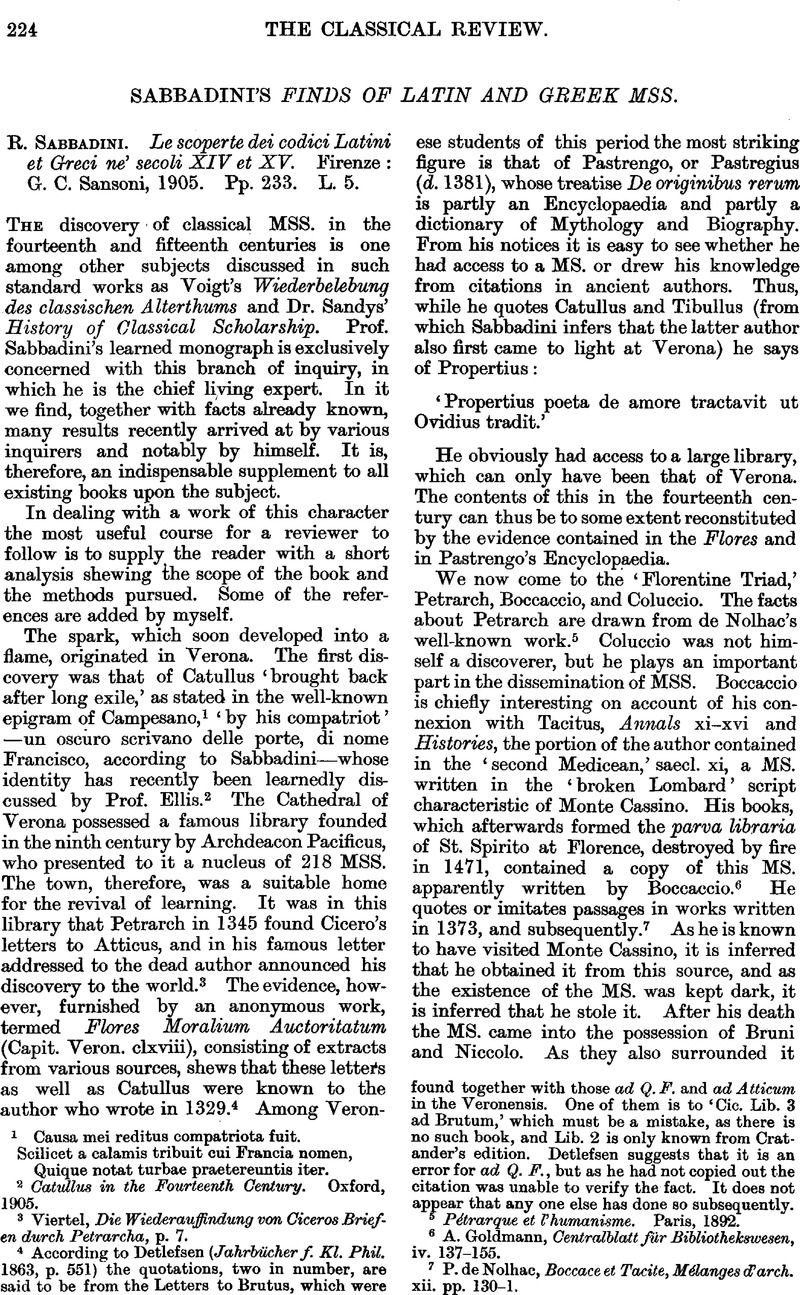No CrossRef data available.
Published online by Cambridge University Press: 27 October 2009

page 224 note 1 Causa mei reditus compatriota fuit.
Scilicet a calamis tribuit cui Francia nomen, Quique notat turbae praetereuntis iter.
page 224 note 2 Catullus in the Fourteenth Century. Oxford, 1905.
page 224 note 3 Viertel, Die Wiederauffindung von Ciceros Briefen durch Petrarcha, p. 7.
page 224 note 4 According to Detlefsen (Jahrbücher f. Kl. Phil. 1863, p. 551) the quotations, two in number, are said to be from the Letters to Brutus, which were found together with those ad Q.F. and ad Atticum in the Veronensis. One of them is to ‘Cic. Lib. 3 ad Brutum,’ which must be a mistake, as there is no such book, and Lib. 2 is only known from Cratander's edition. Detlefsen suggests that it is an error for ad Q. F., but as he had not copied out the citation was unable to verify the fact. It does not appear that any one else has done so subsequently.
page 224 note 5 Pétrarque et l'humanisme. Paris, 1892.Google Scholar
page 224 note 6 A. Goldmann, Centralblatt für Bibliothekswesen, iv. 137–155.
page 224 note 7 P. de Nolhac, Boccace et Tacite, Mélanges d'arch. xii. pp. 130–1.
page 225 note 1 Rostagno, Tacitus cod. Laur. Med. LXVIII. 2, phototypice editus, p. vi.
page 225 note 2 Benvenuti da Imola, in a famous passage, describes the condition in which Boccaccio found the library. ‘Invenit locum tanti thesauri sine ostio clavi ingressueque vidit herbam natam per fenestras et libros omnes cum bancis coopertos pulvere alto.’ The monks tore out leaves or cut off margins to make amulets or Psalters, which they sold for a few soldi to women or children. De Nolhac remarks ‘un vol même dans de pareilles conditions fait aux rats et à la pourriture n' eût point été autre chose qu'œuvre pie et la conscience de Boccace fût trouvée, j'imagine, en repos.’ I would illustrate the methods of Renaissance scholars in dealing with such onagri, to borrow a term from Poggio, by a statement of Bruni contained in a letter Niccoli, in which he confesses to ‘conveying’ a MS. of Livy, Decad ii, from a Roman who brought it to him since ‘libri dominus non satis eruditus his studiis erat nostris.’ He proclaims the doctrine, so often acted upon by bibliophiles, ‘si ius violandum est, librorum gratia violandum est. Ceteris in rebus servato fidem ’ (Misc. Canon. 484, f. 4).
page 225 note 3 On p. 212 Sabbadini says that there came to light ‘un solo esemplare delle Epist. ad Att. di Cicerone e lo dobbiamo alle Capitolare di Verona.’ This statement is not now generally accepted. The codices of Capra and Corvini appear to have been independent: also the cod. Cratandri and the Tornaesianus(Z), the last of which was probably Clun. 492, the MS. described in the twelfth century Cluni Catalogue. Cf. Class. Rev. xvi. p. 327.
page 225 note 4 4 Cf. F. Barbaro, ad Poggium (Epp. 1. 1), ‘te et Bartholomaeum ad hoc munus obeundum summi Romanae ecclesiae principes delectos publice dimiserunt.’
page 226 note 1 Anecdota Oxoniensia, Classical Series, part x p. lxii.
page 226 note 2 Poggio, reporting the story, says ‘Libri sunt in Monasterio de Sora ordinis Cisterciensium prope Roschild ad duo milliaria Theutonica quo adiri potest a Lubich biduo amplius.’ Tonelli, vol. i. p. 104.
page 226 note 2 Jaffé Wattenbach, Ecclesiae Metropolitanae Coloniensis codd. MSS. p. iv.
page 227 note 1 In a letter in my possession he says ‘Si tratta di uno studio storico, paleografico, filologieo interessantissimo e che richie de tempo, il quale m’ è stato tolto in parte dalle occupazioni di scuola … L'assicuro però che la pubblicazione non sarà Iontana.’ Meanwhile the fullest account of the MS., together with photographs, is to be found in Prof. Felice Ramorino's paper ‘De codice Taciti Aesino nuper reperto,’ read by him at the Congresso Internazionale di Scienze storiche, held at Rome 1903.
page 227 note 2 Archivio Mediceo, Filze 62, 63, 64.
page 227 note 3 It will be noticed that Tacitus Annals xi.–xvi. were in the possession of Boccaccio before Poggio was born. Annals i.–vi. were discovered forty-nine years after his death, while he failed to obtain the Hersfeld MS. of the Germania, Agricola, and Dialogus, which was brought to Italy, when Poggio was seventy-five years of age, by Enoch of Ascoli. The fantastic suggestion that Poggio forged the Annals of Tacitus, apart from its inherent absurdity, is, therefore, disproved by historical facts.
page 227 note 4 Cf. Lehmann, De Ciceronis ad Atticum epistulis recensendis, p. 131.
page 228 note 1 Class. Rev. xiii. p. 120, n.
page 228 note 2 Class. Rev. xiii. p. 125.
page 228 note 3 Poggio is accustomed to speak thus of his copyists, e.g. ‘Habeo scriptorem rudis ingenii et moribus rusticanis. lam iv menses nihil aliud ago quam earn docere ut discat scribere, sed vereor ne litus arem. Scribit modo Valerium in quo experitur ruditatem suam. Itaque clamo, intono, urgeo, increpo, at is habet aures picatas, plumbeus, caudex, stipes, asinus et si quid stolidius ineptiusque dici potest. Di eum perdant.’ MS. Biccard. 759 f. 32 v.
page 228 note 4 Tonelli, 1, p. 80.
page 228 note 5 Class. Rev. l.c. I would remark that my suggestion concerning F(Bibl. Aedil. Flor. Eccl. exevi.), which contains Silius Italicus, was subsequently withdrawn by me (Class. Rev. xv. 166) after I had obtained a photograph of a page in this MS.
page 229 note 1 Cf. Valliére, Catalogue (cur. de Bure, 1783), vol. ii. p. 26.